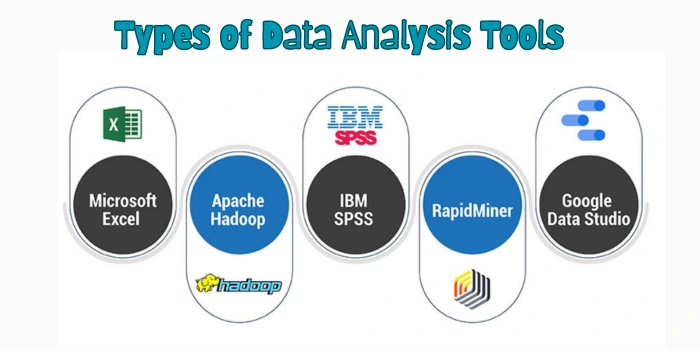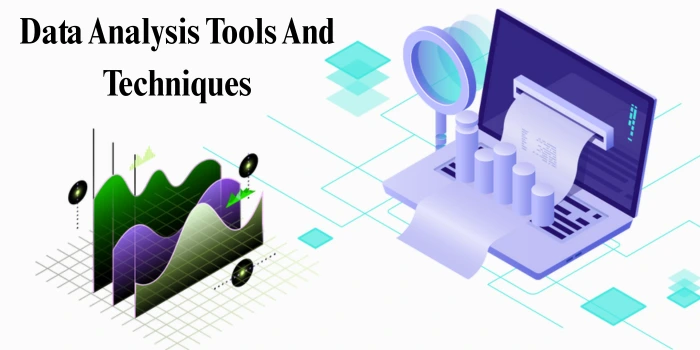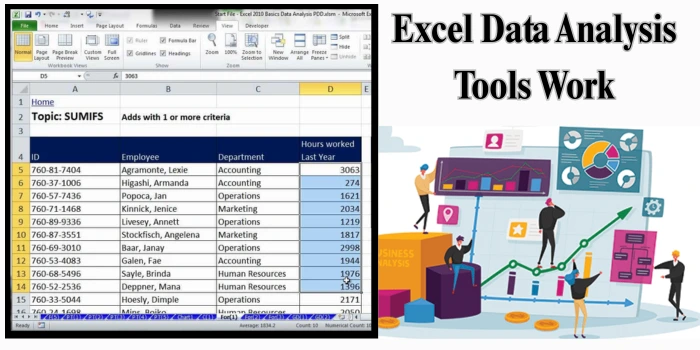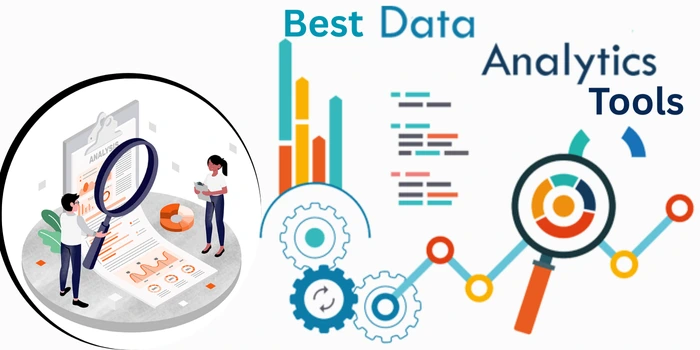In today’s data driven world having the right tools for analysing big datasets is vital for making knowledgeable decisions. Agencies depend upon effective Data Analysis Tools to gather, system and interpret complex information from diverse sources. These gears help discover hidden patterns, traits, and relationships in records, enabling accurate insights that drive strategic selections. From simple visualisation software to superior predictive analytics structures, an extensive range of solutions caters to one of a kind commercial enterprise needs. Marketplace leaders, including Tableau, electricity BI and SAS Analytics, provide intuitive interfaces and effective features for statistics visualisation, statistical modelling and predictive evaluation. Additionally, gear like Python and R provide bendy programming environments for in-depth information management and gadget gaining knowledge of packages. Whether or not it is customer segmentation, market forecasting or operational efficiency, using the right information analysis tools ensures corporations stay aggressive and future-prepared. This manual will discover the first-rate equipment for information evaluation, including many other tools that specialists use throughout industries.
Table of Contents
ToggleWhat Are Data Analysis Tools?
Data analysis tools are software applications and structures that help corporations, researchers, and individuals interpret raw information into significant insights for decision-making. They encompass conventional Excel data analysis tools, which remain extensively used for statistical calculations, visualisation, and reporting. Advanced AI tools for Excel data analysis similarly decorate Excel by means of automating trend detection, forecasting and predictive modelling.
The most popular BI tools for data analysis, such as Strengths BI, Tableau and Qlik, which give interactive reporting and real-time dashboards for organization records, are often utilized by corporations for data evaluation. Data analysis with open source tools like R, Python and Apache Spark offers flexibility and scalability for those looking for inexpensive picks. While utilised in tandem, the gadgets permit organisations to enhance productivity, optimise tactics and achieve a competitive edge. If you’re exploring reliable digital resources that cover tools, systems, automation, and AI-driven solutions, you can visit Power System Cart for in-depth guides and strategies.
Types of Data Analysis Tools Available

Here are the types of Data Analysis Tools:
- Statistical Tools for Data Analysis
- This equipment assists in discovering styles, correlations, and tendencies through the use of mathematical fashions. Not unusual statistical tools for data analysis consist of SPSS, SAS, Stata, and R.
- Qualitative Data Analysis Tools
- When dealing with text, interviews, or case studies, consider using data analysis tools for qualitative research, such as NVivo or Atlas. It helps identify themes and categorise responses.
- Quantitative Data Analysis Tools
- For surveys, experiments, and numerical facts, quantitative data analysis tools such as Python libraries (NumPy, Pandas), MATLAB, and Excel provide accurate computations.
- Unstructured Data Analysis Tools
- With the rise of social media, images, and audio data, unstructured data analysis tools like Apache Hadoop, Spark, and AWS Comprehend are gaining traction.
- Exploratory Data Analysis Tools
- Data scientists rely on exploratory data analysis tools such as Python’s Pandas Profiling, RStudio, and Jupyter Notebooks to uncover initial patterns before modelling.
Which Are the Free Data Analysis Tools Available Today?
Not every organisation can invest heavily in data solutions. Luckily, several Free Data Analysis Tools exist. Examples include:
- Google Sheets with built-in Data Analysis Tools and Excel functions.
- RStudio, a Source Data Analysis tool platform.
- Python with Python Tools for Data Analysis libraries like Pandas and NumPy.
These Data Analysis Tools Free solutions are perfect for startups, students, and small businesses.
AI and Automation in Data Analysis
The emergence of data analysis AI tools has revolutionised the field. Today, businesses can use generative AI tools for data analysis and automated data analysis tools to fast identify traits, predict destiny consequences and generate reviews with minimal human effort. Several best AI tools for data analysis 2025 consist of ChatGPT-powered plugins, DataRobot, IBM Watson and MonkeyLearn. Businesses searching for free AI tools for data analysis can explore OpenAI API integrations, Google AI equipment or open-source AI frameworks. For team collaboration, platforms like Airtable and Concept offer top tools for team data analysis, making it less difficult to control tasks together.
How do Data Visualisation and Reporting Tools improve decision-making?
Data Visualisation and Reporting Tools are imperative for enhancing commercial enterprise decision-making because they redesign unprocessed information into clear, useful insights. Choice-makers can also extra effects understand complex facts at a glance, thanks to modern data analysis and visualisation tools that allow organisations to fast spot tendencies, styles and anomalies. Those tools provide interactive dashboards and visible reports that simplify communication across groups. Additionally, reporting Tools For Data Analysis generate designated summaries, permitting corporations to sing overall performance metrics and reveal KPIs efficiently.
The combination of data analysis and reporting tools ensures that selections are sponsored by using accurate and dependable information as opposed to guesswork. With the developing demand for agility, real time data analysis tools empower corporations to respond instantly to marketplace adjustments, consumer behaviour or operational troubles. With the aid of offering clarity, pace, and precision, this equipment significantly enhances the pleasure of strategic and operational selections in today’s competitive surroundings.
Key Data Analysis Tools And Techniques

When discussing data analysis tools and techniques, it’s important to highlight the different approaches:
- Descriptive analysis (past data trends)
- Diagnostic analysis (causes of trends)
- Forecasting future results with predictive analysis
- Prescriptive assessment (action recommendations)
By means of combining these methodologies with analytical tools for data analysis, companies can ensure information-driven decision-making.
How Do You Choose the Right Data Analysis Tool?
Choosing the appropriate gadget depends on a few factors:
- Data Volume: Excel or Google Sheets work nicely with small datasets while Hadoop and Spark are suitable for large datasets.
- Technical Expertise: Person-friendly equipment like Tableau or strength BI requires minimum programming know-how, whereas R or Python-primarily based gear is for advanced customers.
- Cost: Open-supply tools (R, Python, Talend) are cost-effective but might also require greater technical capabilities, industrial equipment (SAS, Tableau) include licensing fees; however provide customer service and sturdy features.
- Integration: Ensure the device integrates well with existing structures and databases.
- Scalability: Pick out equipment that could cope with the destiny data boom.
What Are the Best Practices for Data Analysis?
Following the described processes is integral earlier than starting any research on the way to guarantee accuracy, consistency and sizable consequences. Businesses may also maximise the fee of their information and make more informed decisions by implementing first-class practices.
- Define Clear Objectives: Decide on your desires for using document evaluation.
- Data Quality Assurance: Often clean and validate information.
- Use Visualisations Wisely: Ensure charts and graphs are easy to interpret.
- Document Analysis Processes: Hold exact facts of methodologies and findings.
- Regular Training: Hold teams up to date with the latest tools and strategies.
Why Do Businesses Need the Best Tools for Data Analysis?

To make better decisions, streamline processes and maintain their competitiveness in a market that is driven by facts, businesses require the Best Data Analysis Tools. With Marketing Data Analysis Tools, businesses can better recognise purchaser behaviour, degree campaign performance overall and personalise techniques that drive better engagement and conversions. Additionally, the Best Tools For Ai Search Data Analysis History assists businesses song past trends, perceive styles, and expect future demands, which is imperative for enhancing customer enjoyment and product services. Via integrating those superior answers, companies reduce mistakes, save time and gain actionable insights that lead to innovation and growth. In today’s virtual generation, having the proper records evaluation toolkit is not just an advantage, it’s a necessity for lengthy-time period achievement.
How Do Financial Data Analysis Tools Help Businesses?
Financial Data Analysis Tools play a crucial role in contemporary commercial enterprises by assisting accounting, forecasting and risk management. They permit organisations to music monetary financial performance, check profitability and make informed investment selections. The Best Financial Analysis Tools for Business Data encompasses solutions like QuickBooks, Zoho Analytics and SAP Analytics Cloud, which can be extensively used by corporations of all sizes. These platforms provide advanced features for tracking budgets, analysing coin glide and generating certain economic reports. CFOs and finance teams depend on such equipment to improve decision-making, streamline operations and develop long-term planning. By way of leveraging those effective programs, groups can discover risks, maximise returns, and maintain financial stability in aggressive markets.
Data Analysis Tools in Research and Healthcare
In each study and healthcare, data analysis tools play an integral function in extracting significant insights, enhancing accuracy and ensuring informed decision-making. These tools help researchers and healthcare professionals manipulate massive datasets, identify patterns, and gain dependable results.
Data Analysis Tools in Research
- Instructional researchers use tools for data analysis in research, including SPSS, R, NVivo, and EndNote for both qualitative and quantitative insights.
Clinical Data Analysis Tools
- The healthcare enterprise is predicated on clinical data analysis tools like SAS Clinical, OpenClinica and Medidata to ensure patient protection, monitor trials and meet regulatory requirements.
Choosing the Best Data Analysis And Tools
With so many options, how do you select the best tools for data analysis or the top data analysis tools?
Factors to consider:
- Nature of data (based vs. unstructured)
- Industry
- Budget (premium or free data analysis tools)
- Scalability (small businesses vs. tools for big data analysis)
- AI integration (traditional vs. Free AI data analysis tools)
If you’re seeking innovation, check out the top 10 AI tools for data analysis for the latest updates in 2025.
How Do Excel Data Analysis Tools Work?

Data Analysis Tools in Excel are many of the most famous tools worldwide, supplying effective functions that simplify reporting and decision-making. Integrated alternatives like pivot tables, charts, and Power BI make it smooth to organise, visualise and interpret large datasets. These gears are broadly used throughout industries for monetary modelling, advertising insights and research initiatives. With the addition of AI Tools for Excel Data Analysis, professionals can now automate duties, locate traits and generate predictive insights greater accurately. This mixture of conventional and AI-driven capabilities makes Excel one of the maximum flexible and reliable tools for data analysis available nowadays.
Why Are Big Data Analysis Tools Important Today?
With the explosion of data across numerous industries, conventional spreadsheets can now longer efficiently deal with extensive amounts of data. Big data analysis tools make it feasible to manage structured, semi-structured and unstructured records in real time. This equipment allows companies to examine consumer behaviour, predict future trends and enhance operational performance. Famous big information tools encompass Hadoop, Spark and Tableau, which systems thousands and thousands of information simultaneously. Corporations rely upon them for threat management, fraud detection and patron experience optimisation. Without these gears, current companies might hostilities to remain aggressive.
What Are Some Common Tools in Data Analysis?
There are various tools in data analysis, starting from loose open-source systems to enterprise-grade solutions.
- Excel Data Analysis Tools: Easy for beginners with pivot tables, charts, and Power Query.
- Python Data Analysis Tools: Libraries like Pandas, NumPy, and Matplotlib for deep data science.
- Microsoft Data Analysis Tools: Power BI for visualisation and advanced reporting.
- Google Data Analysis Tools: Google Analytics and BigQuery for online and cloud-based information.
- Business Data Analysis Tools: Platforms like SAS, Zoho Analytics and SAP for agency use.
- Dcmp data analysis tools: Specialised frameworks designed for educational and scientific data handling.
These solutions vary in complexity, features, and purpose, making them adaptable to different industries.
Can You Give Some Data Analysis Tools Examples?
Yes, here are some key data analysis tools examples across categories:
- R, SAS, and SPSS are statistical analysis tools.
- Visualisation: Microsoft Power BI and Tableau.
- Python based programming.
- Online equipment: Zoho Analytics and Google Analytics.
- Big Data Processing: Apache Spark and Hadoop.
Each tool caters to special wishes whether for statistical modelling, big data, visualisation or consumer analytics.
How Do Advanced Analytics Tools Help in Marketing Data Analysis?
Advanced analytics tools for marketing data analysis allow agencies to head beyond primary reports. Advanced analytics equipment for marketing data analysis allows agencies to head beyond primary reports. They offer prescriptive and predictive data to improve advertising and marketing, customise customer remarks, and boost return on investment. HubSpot, Adobe Analytics and Google Analytics 360, as an instance, examine goal marketplace conduct across numerous channels. They assist entrepreneurs in understanding consumer journeys, forecasting campaign performance and allocating budgets efficiently. Via leveraging this equipment, agencies could make smarter advertising selections based on actual statistics in preference to assumptions. Via leveraging this equipment, agencies could make smarter advertising selections based on actual statistics in preference to assumptions.
How Does Python Compare to Specialised Data Analysis Tools?
Python has gained giant recognition for records evaluation, commonly because of its flexibility and massive environment of libraries such as Pandas, NumPy, Matplotlib, Seaborn and Scikit-learn.
Not like point-and-click software programs, Python provides complete control over information management, statistical calculations and gadget studying model improvement. Statistics scientists can write custom scripts to handle complex information workflows, automate approaches and build predictive models.
Python is especially beneficial for:
- Data cleaning and manipulation (Pandas).
- Analysis of statistics (SciPy).
- Data visualisation (Seaborn, Matplotlib).
- Machine learning (TensorFlow, Scikit-learn).
Although it calls for programming know-how, Python offers remarkable flexibility, reproducibility of analysis and community aid, making it best for advanced users.
Future of Data Analysis Tools
Looking ahead, the best AI Tools For Data Analysis 2025 will dominate, combining automation, machine learning, and natural language queries. Businesses will increasingly adopt online data analysis tools and cloud-based tools data analysis platforms for global collaboration.
The future of data analysis AI tools looks promising with these trends:
- AI and Machine Learning Integration: More automatic selection-making.
- Natural Language Processing (NLP): Conversational queries for insights.
- Cloud-Based Solutions: Extended accessibility and collaboration.
- Augmented Analytics: Tools suggesting insights without manual effort.
- IoT and Real-Time Analytics: Handling data from smart devices.
FAQs
Where To Find Best Team Data Analysis Tools?
The solution lies in exploring marketplaces, open-source communities, or organisation providers. Microsoft, Google, IBM and Oracle provide company-grade systems, at the same time as GitHub and Kaggle groups provide open-source solutions.
What are qualitative data analysis tools?
Qualitative information analysis software like NVivo and ATLAS.ti is used to look at non-numerical records, including interviews, surveys and text documents. They are not unusual in academic research and social sciences.
How do Excel data analysis tools help professionals?
Excel data analysis tools offer pivot tables, electricity query and AI integrations to simplify reporting and visualisation. They’re specifically beneficial for finance, research, and advertising professionals.
What Are the Key Challenges of Using Data Analysis Tools?
Here are the Key Challenges of Using Data Analysis Tools:
- High Costs: Enterprise-level tools can be expensive.
- Steep Learning Curve: Advanced platforms require technical expertise.
- Data Security Risks: Cloud-based answers can also face compliance challenges.
- Integration Issues: No longer do all tools work seamlessly with the present structures.
- Data Quality Problems: Insights are only as excellent as the facts being analysed.

